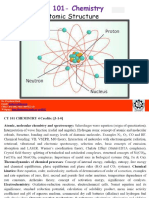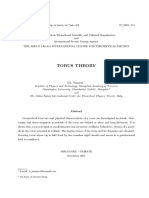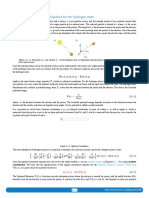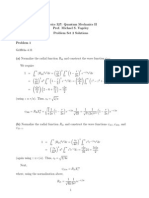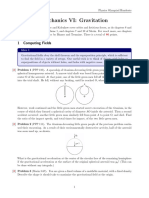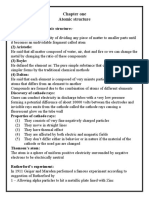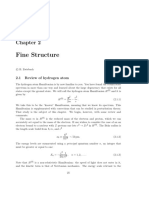Theory Lecture 10 PDF
Theory Lecture 10 PDF
Uploaded by
sb24112007jeeCopyright:
Available Formats
Theory Lecture 10 PDF
Theory Lecture 10 PDF
Uploaded by
sb24112007jeeCopyright
Available Formats
Share this document
Did you find this document useful?
Is this content inappropriate?
Copyright:
Available Formats
Theory Lecture 10 PDF
Theory Lecture 10 PDF
Uploaded by
sb24112007jeeCopyright:
Available Formats
ATOMIC STRUCTURE (LECTURE # 10)
(A) Schrodinger Wave Mechanical model
Ervin Schrodinger developed a model which is based on the particle and wave nature of the
electron, known as Wave Mechanical Model of atom.
The equation determines the behaviour of the wave function that describes the wave like
properties of subatomic system. It is solved to find the different energy levels of the system.
Schrodinger applied the equation to the hydrogen atom and predicted many of its properties
with remarkable accuracy. The differential wave equation is as follows :
2 2 2 8 2m
(E V ) 0
x 2 y 2 z 2 h2
where m is mass of electron, is wave function, E is total energy of electron, V is potential energy
and h is Planck's constant.
Wave function has no actual physical meaninig but the value of 2 describes the probability
distribution of an electron.
When we solve the Schrodinger equation, it is observed that for some region of space, the value
of is positive and for other, it is negative. But the probability must be positive, so it is proper to
use 2 in place of .
The Schrodinger equation is said to have been solved for a particular atomic system. The details
of, how this is done, are beyond the syllabus, but the consequences of its solution are extremely
important to us
The important point of the solution of this equation is that it provides a set of numbers called
quantum numbers.
Quantum numbers are required to describe the distribution of electrons in atoms.
Quantum numbers derived from the solution of Schrodinger equation are called principal quantum
number, azimuthal quantum number and magnetic quantum number.
These quantum numbers are used to describe the atomic orbitals.
Orbital : The locations in space at which the probability of finding the electron is maximum.
Node and Nodal Plane : Node represents the region where probability of finding an electron is zero (i.e.,
and 2 = 0). Similarly nodal plane represents the plane having zero probability of finding elec-
tron.
The 2p-orbitals of the hydrogen atom.
Head Office : 141-A, Vyas Lane, Talwandi, Kota (Raj.)
Mob. 08448447848 | Online Learning 1
Website : www.vyasedification.com
The 3d-orbitals of the hydrogen atom.
(r) i.e. radial part of wave function depends upon quantum number n and l and decides the size
of an orbital.
Angular part of wave function (– ), depends upon quantum numbers l and m and describes
the shape of orbital.
For the sake of convenience the (r) vs. r and ( , ) vs. angle are plotted seperately.
An atomic orbital is a one electron wave function (r, , ) obtained from the solution of the
Schrodinger equation.
The orbital wave function has no physical significance but its square (2) has a physical signifi-
cance it measures the electron probability density at a point in an atom.
The Schordinger equation can also be written in terms of spherical polar coordinates (r) in
addition to Cartesian coordinate x, y, z.
Since, H-atom posses spherical symmetry, it is easier to solve schordinger equation if it is
represented in polar coordinate.
z
z r cos
r cos
x r sin . cos
y r sin sin
r
y
r sin
x
x 2 y 2 z 2 R2
When schordinger equation in polar coordinate is solved for H-atom then the solution obtained
can be expressed as
r . .
r represents radial wave function which depends on n, .
. Angular wave function which depends on m, .
(Psi) : [Wave function or Amplitude of Electron Wave]
It is also known as atomic orbitals. It is a mathematical function whose value depends on
coordinates of electron in an atom. It may be +ve or –ve depending upon value of coordinates
and it has no physical significance.
Head Office : 141-A, Vyas Lane, Talwandi, Kota (Raj.)
Mob. 08448447848 | Online Learning 2
Website : www.vyasedification.com
(B) Significance of Radial wave function (R) or
In all cases R approaches zero as r approaches infinity.
We finds that there is a node in the 2s radial function.
At the node the value of the radial function changes from positive to negative.
In general, it has been found that ns-orbitals have (n–1) radial nodes and np-orbitals have (n–2)
radial nodes etc.
Note: An orbital in an atom can be represent as nlm. Where n, l, m are quantum numbers which have
their general meaning.
Orbital representation n l m
1s 100 1 0 0
2s 200 2 0 0
2px / 2py / 2pz 210/211 2 1 –1, 0, +1
3s 300 3 0 0
3px / 3py / 3pz 310/311 3 1 –1, 0, +1
3dx2y2 / 3dz2 / 3dxy/3dyz/3dxz 320/321/322 3 2
(C) significance of Radial Probability density (R2) or 2
r
The radial density R2 gives the probability density of finding the electron at a point along a
particular radius line.
It may be noted that for s-orbitals the maximum electron density is at the nucleus while all other
orbitals have zero electron density at the nucleus.
Its zero value (R2 = 0) indicates zero probability of finding an electron.
Head Office : 141-A, Vyas Lane, Talwandi, Kota (Raj.)
Mob. 08448447848 | Online Learning 3
Website : www.vyasedification.com
(D) Significance of Radial probability function 2 × 4r2dr
Since the atoms have spherical symmetry, It is more useful to discuss the probability of finding the
electron in a spherical shell between the spheres of radius (r + dr) and r.
The volume of the shell is equal to 4/3(r + dr)3 – 4/3r3 = 4r2dr.
As discussed earlier that 2 gives the probability distribution for electron with respect to the
nucleus. In order to understand the concept of radial probability let us assume that the space
around the nucleus is divided into large number of concentric shells of thickness dr.
Volme of the sphere Volme of sphere
So,volume of the radial shell = –
with radius (r dr ) with radius r
4 4
= (r + dr)3 – r3
3 3
4 4 3
r 3r dr 3r (dr ) ( dr ) r
3 2 2 3
=
3 3
= × 3r2dr = 4r2dr [Since (dr)2 and (dr)3 are very small and can be neglected]
Now radial probability = probability density × volume of the radial shell = 2 × 4r2dr
5
16
14
4
12 node
10 3
8
6 2
4
1
2
0
0 1 2 3 4 0
0 1 2 3 4 5 6 7 8 9
r/a0 r/a0
; ;
This probability which is independent of direction is called radial probibility and is equal to [4r2drR2].
It gives the probability of finding the electron at a distance r from the nucleus regardless of
direction.
Head Office : 141-A, Vyas Lane, Talwandi, Kota (Raj.)
Mob. 08448447848 | Online Learning 4
Website : www.vyasedification.com
Ex. Which of the following symbols represent an atomic orbital ?
(A)n, , m = Rn m (B)n, , m = Rn, m
(C)n, , m = Rn ,m m (D*)n, , m= R n, ,mm
Ex. Probability of finding the electron y2 of ‘s’ orbital does not depend upon
(A) distance from the nucleus (r)
(B) energy of ‘s’ orbital
(C) principal quantum number
(D*) azimuthal quantum number
Ex. The schrodinger wave equation for hydrogen atom is
3
2
1 1 r a0
2s 2 e
4 2 a0 a0
where a0 is Bohr’s radius. If the radial node in 2s be at r0, then r0 would be equal to:
a0 a0
(A) (B*)2a0 (C) 2a0 (D)
2 2
Ex. If 0.53 Å is Bohr’s radius for the first orbit. It suggest in the light of the wave mechanical model
that
(A*) the product of 2 and 4r2dr increase till it reaches at the distance of 0.53 Å
(B) only 2 goes on increasing, 4r2dr remains constant till it reaches at the distance of 0.53Å
(C) 2 goes on increasing , 4r2dr goes on decreasing till it reaches at the distance of 0.53Å
(D) only 4r2dr goes on increasing , 2 remains constant till it reaches at the distance of 0.53Å
Ex. Identify the correct statements-
(A) An electronic wave function must be symmetrical with respect to the interchange of any two
electrons
(B*) 2 must remain unchanged when the spin and space coordinates of the paired electrons are
interchanged
(C*) For an n electron system the wave function will be a function of 3 n spatial coordinate
(D*) Antisymmetrical wavefunction are found to represent the properties of electron.
Ex. The probability distribution curve for 2s electron appears like –
R2 R2
(A*) (B)
r r
R
2
R
(C) (D*)
r r
Head Office : 141-A, Vyas Lane, Talwandi, Kota (Raj.)
Mob. 08448447848 | Online Learning 5
Website : www.vyasedification.com
3/2
11 r r /a0
Sol. 2s = × × 2 e
4 2 a0
a0
2
r 2r /a0
2 2 e
2s = K a0
Ex. Column I Column II
(A) 310 (p) 5 f
(B) 120 (q) 3 p x or 3 p y
(C) 530 (r) 3 pz
(D) 311 (s) impossible
Ans. A-r; B-s; C-p; D-q
EX. Column I & Column II contain data on Schrondinger Wave-Mechanical model, where symbols
have their usual meanings. Match the columns :-
Column I Column II (Type of orbital)
r
(A) (p) 4s
r 4 r
2 2
(B) (q) 5px
(C) () = K (independent of & ) (r) 3s
(D) atleast one angular node is present (s) 6dxy
Ans. A-p; B-pqs; C-pr; D-qs
Head Office : 141-A, Vyas Lane, Talwandi, Kota (Raj.)
Mob. 08448447848 | Online Learning 6
Website : www.vyasedification.com
You might also like
- Radial Wave Function and Angular Wave FunctionsDocument8 pagesRadial Wave Function and Angular Wave FunctionsBhavesh Garg100% (4)
- Atomic PhysicsDocument18 pagesAtomic PhysicsAnonymous ffLrUFNo ratings yet
- Gen Chem-Lect 11-05-09-24Document23 pagesGen Chem-Lect 11-05-09-24korasikha27No ratings yet
- AtomicStrucure SlidesDocument17 pagesAtomicStrucure SlidessamebalutNo ratings yet
- Indian Institute of Technology, Guwahati: CH101 Class 11 Physical ChemistryDocument5 pagesIndian Institute of Technology, Guwahati: CH101 Class 11 Physical ChemistryMihir Kumar MechNo ratings yet
- Atomic Structure: CY 101-ChemistryDocument16 pagesAtomic Structure: CY 101-ChemistrypabitraNo ratings yet
- Atomic Struture - Amit NagDocument4 pagesAtomic Struture - Amit NagKrishna SaxenaNo ratings yet
- Diklic TNSDocument17 pagesDiklic TNSJosipa DiklićNo ratings yet
- Lecture 4 Wavefunction NewDocument53 pagesLecture 4 Wavefunction NewkedirNo ratings yet
- Lecture 04Document13 pagesLecture 04sandrajychungNo ratings yet
- Schrodinger QuestionDocument3 pagesSchrodinger Questionlaptopyadav65No ratings yet
- Chaotic Behaviour of Atomic Energy LevelsDocument7 pagesChaotic Behaviour of Atomic Energy LevelsDele AdigunNo ratings yet
- Quantum Mechanics Course ZeemansplittingDocument29 pagesQuantum Mechanics Course ZeemansplittingjlbalbNo ratings yet
- Exact Solutions of The Radial SCHR Odinger Equation For Some Physical PotentialsDocument12 pagesExact Solutions of The Radial SCHR Odinger Equation For Some Physical PotentialsHELDER CHAVEZNo ratings yet
- BITS Pilani Chemistry Hamilton OperatorDocument11 pagesBITS Pilani Chemistry Hamilton OperatorNaresh SehdevNo ratings yet
- DPP25 Atomic Structure Part-2 Modern ConceptDocument3 pagesDPP25 Atomic Structure Part-2 Modern Conceptuddeshranaprsnl766sNo ratings yet
- Chapter 1 - Basic Concepts: Atoms: Discovery of Atomic Structure Rutherford (1910)Document19 pagesChapter 1 - Basic Concepts: Atoms: Discovery of Atomic Structure Rutherford (1910)Anulisa DasNo ratings yet
- Lecture 3 NotesDocument5 pagesLecture 3 Notesabdurmasood0811No ratings yet
- sis-2002-360Document27 pagessis-2002-360Daniel KopmanNo ratings yet
- Junoon e Jee Atomic Structures 2Document127 pagesJunoon e Jee Atomic Structures 2Parth ShelarNo ratings yet
- Deuteronlec06 PDFDocument5 pagesDeuteronlec06 PDFAsh LeyNo ratings yet
- Wave FN A SDocument5 pagesWave FN A SQwertyNo ratings yet
- 2.01 The Schrodinger Wave Equation For The Hydrogen AtomDocument10 pages2.01 The Schrodinger Wave Equation For The Hydrogen AtomRumbaNo ratings yet
- مصطفى محمد (2)Document21 pagesمصطفى محمد (2)البياتي محمدNo ratings yet
- Pool 1 - Quantum Theory and Hydrogenic Atoms - RKG - CCDocument6 pagesPool 1 - Quantum Theory and Hydrogenic Atoms - RKG - CCessmanoj.2022No ratings yet
- Atomic StructureDocument28 pagesAtomic StructurePavan GoudNo ratings yet
- Radial and Angular Parts of Atomic OrbitalsDocument7 pagesRadial and Angular Parts of Atomic OrbitalsArchisman MisraNo ratings yet
- 10 Self-consistent field theory: ² ψ − ∇ ψ dr - ψ - r − r - ψ δ dr ψ - r − r - ψDocument4 pages10 Self-consistent field theory: ² ψ − ∇ ψ dr - ψ - r − r - ψ δ dr ψ - r − r - ψursml12No ratings yet
- Chapter 1 - Basic Concepts: Atoms: Prerequisite KnowledgeDocument20 pagesChapter 1 - Basic Concepts: Atoms: Prerequisite KnowledgemahyarbNo ratings yet
- 3.hydrogen Atom Wave FunctionsDocument8 pages3.hydrogen Atom Wave FunctionsSALEEL ENo ratings yet
- Gen Chem-Lect 9-02-09-24Document33 pagesGen Chem-Lect 9-02-09-24korasikha27No ratings yet
- 14 SemiconductorsDocument20 pages14 Semiconductorssuchit.ijantakarNo ratings yet
- 316chem Chap 4Document62 pages316chem Chap 4jumana sayedNo ratings yet
- Handout of Physical Chemistry: Course: Vikaas (Ja) Target: Jee (Advanced)Document6 pagesHandout of Physical Chemistry: Course: Vikaas (Ja) Target: Jee (Advanced)Naunidh Singh MadhokNo ratings yet
- Chapter 12 Quantum Mechanics and Atomic Theory 497Document2 pagesChapter 12 Quantum Mechanics and Atomic Theory 497FrnyanaNo ratings yet
- Tutorial 1 - To 4 AMPDocument4 pagesTutorial 1 - To 4 AMPKay r starNo ratings yet
- Radial Motion Into An Einstein-Rosen Bridge: Physics Letters BDocument7 pagesRadial Motion Into An Einstein-Rosen Bridge: Physics Letters Bryanganicete76No ratings yet
- MO Lecture Course-2 PDFDocument20 pagesMO Lecture Course-2 PDFaneeshssaNo ratings yet
- Alkali SpectraDocument8 pagesAlkali SpectraVivek DewanganNo ratings yet
- Life Inside Black HolesDocument5 pagesLife Inside Black HolesAdonai Jireh Dionne BaliteNo ratings yet
- The Kerr-Newman - (Anti-) de Sitter Spacetime: Extremal Configurations and ElectrogeodesicsDocument22 pagesThe Kerr-Newman - (Anti-) de Sitter Spacetime: Extremal Configurations and ElectrogeodesicsYoni Ramirez RoblesNo ratings yet
- AppendixbDocument3 pagesAppendixbapi-26021617No ratings yet
- BITS PILANI Chemistry Lectures Principal Quatum NumberDocument31 pagesBITS PILANI Chemistry Lectures Principal Quatum NumberNaresh SehdevNo ratings yet
- Canonical Quantization Inside The Schwarzschild Black Hole: U. A. Yajnik and K. NarayanDocument9 pagesCanonical Quantization Inside The Schwarzschild Black Hole: U. A. Yajnik and K. NarayanJuan Sebastian RamirezNo ratings yet
- Exercises 3Document3 pagesExercises 3Jerry CohenNo ratings yet
- Potential Scattering: 2. Also in This Section, We Consider The Threshold Behaviour WhenDocument54 pagesPotential Scattering: 2. Also in This Section, We Consider The Threshold Behaviour WhenAlessandra Souza BarbosaNo ratings yet
- Problem Set 5: University of Alabama Department of Physics and Astronomy PH 126 Leclair Fall 2011Document11 pagesProblem Set 5: University of Alabama Department of Physics and Astronomy PH 126 Leclair Fall 2011AngelicaDominguezNo ratings yet
- Radial Probabilities: NLM NL LMDocument2 pagesRadial Probabilities: NLM NL LMShreeshSwarajNo ratings yet
- Dynamics of Microscopic SystemsDocument16 pagesDynamics of Microscopic Systemshassantech.ngNo ratings yet
- Radial and Angular Parts of Atomic OrbitalsDocument3 pagesRadial and Angular Parts of Atomic OrbitalsW47K3R 27886No ratings yet
- Molecules Levels: Diatomic According TO Wave Mechanics. VibrationalDocument8 pagesMolecules Levels: Diatomic According TO Wave Mechanics. VibrationalSandipan SahaNo ratings yet
- DeuteronDocument37 pagesDeuteronRishav SaikiaNo ratings yet
- Soluciones A Problemas de Mecaninca CuanticaDocument7 pagesSoluciones A Problemas de Mecaninca CuanticaIván GarcíaNo ratings yet
- Mechanics VI: Gravitation: 1 Computing FieldsDocument24 pagesMechanics VI: Gravitation: 1 Computing Fields66 SB jay gotiNo ratings yet
- Mechanics VI: Gravitation: 1 Computing FieldsDocument23 pagesMechanics VI: Gravitation: 1 Computing FieldsKartik AgarwalNo ratings yet
- Mexhanics vol 6Document24 pagesMexhanics vol 6nooob9316No ratings yet
- Salazar2020 Article ElectricVectorPotentialFormulaDocument28 pagesSalazar2020 Article ElectricVectorPotentialFormulaMiguel Angel Gonzalez JaimesNo ratings yet
- 2024 2025 Class XI Chemistry Chapter 2 AWDocument6 pages2024 2025 Class XI Chemistry Chapter 2 AWmelano9797No ratings yet
- Structur Prop StudV WFigDocument68 pagesStructur Prop StudV WFigVarunRajNo ratings yet
- Understanding Vector Calculus: Practical Development and Solved ProblemsFrom EverandUnderstanding Vector Calculus: Practical Development and Solved ProblemsNo ratings yet
- 3.chemistry Ntse X Class (63 85)Document23 pages3.chemistry Ntse X Class (63 85)J SoujanyaNo ratings yet
- Chemical Periodicity: Alvan F. Shalas, M.Farm., AptDocument33 pagesChemical Periodicity: Alvan F. Shalas, M.Farm., AptNaufal HibbanNo ratings yet
- Chapter One Atomic SturctureDocument7 pagesChapter One Atomic SturctureWorld ShortsNo ratings yet
- General Chemistry Quarter 2 Week 1 3Document7 pagesGeneral Chemistry Quarter 2 Week 1 3Istian VlogsNo ratings yet
- EP1108 - Stern-Gerlach Experiment and Spin: Shantanu DesaiDocument13 pagesEP1108 - Stern-Gerlach Experiment and Spin: Shantanu DesaiAnirudh ReddyNo ratings yet
- Marcelo H. Del Pilar National High SchoolDocument6 pagesMarcelo H. Del Pilar National High SchoolCarl Lawrence R. CarpioNo ratings yet
- SCIENCE 9 EXAM (2nd Quarter) QuestionsDocument3 pagesSCIENCE 9 EXAM (2nd Quarter) QuestionsKert Cyrel RomeroNo ratings yet
- Paolasini Magnetism Lecture2Document33 pagesPaolasini Magnetism Lecture2Abdeljalil LoudainiNo ratings yet
- Grade 9 - 2nd Quarter - Week 1 Day 1-2Document16 pagesGrade 9 - 2nd Quarter - Week 1 Day 1-2Marjohn ElentorioNo ratings yet
- CHEMISTRYDocument70 pagesCHEMISTRYF E R N A NNo ratings yet
- (Philosophy of Science 1964-Oct Vol. 31 Iss. 4) Peter Achinstein - Models, Analogies, and Theories (1964) (10.2307 - 186263) - Libgen - LiDocument24 pages(Philosophy of Science 1964-Oct Vol. 31 Iss. 4) Peter Achinstein - Models, Analogies, and Theories (1964) (10.2307 - 186263) - Libgen - Lidreamysky404No ratings yet
- Chemistry - Atomic Structure - Gaseous State - Complete ModuleDocument122 pagesChemistry - Atomic Structure - Gaseous State - Complete Moduleruchir angra100% (1)
- Gas Laws: Development of Atomic Theory Early Atomic TheoryDocument3 pagesGas Laws: Development of Atomic Theory Early Atomic TheoryLia BuenavistaNo ratings yet
- Xi Ch#03 p.s#01 Haresh-1Document6 pagesXi Ch#03 p.s#01 Haresh-1papukhan67zkqNo ratings yet
- 1.atomic Structure Chooses (Bits Part)Document47 pages1.atomic Structure Chooses (Bits Part)monika gompaNo ratings yet
- Structure of Atoms: NEET/JEE: 2020-21Document2 pagesStructure of Atoms: NEET/JEE: 2020-21shantinath123gmailcoNo ratings yet
- Gen Chem 1 NotesDocument47 pagesGen Chem 1 NotesMilescent Rose Juguilon PadillaNo ratings yet
- Doc-20230304-Wa0000 230704 130512PDF 230704 130544Document33 pagesDoc-20230304-Wa0000 230704 130512PDF 230704 130544Seshakrishna SrinivasanNo ratings yet
- FinelDocument20 pagesFinelAli RafaatNo ratings yet
- Structure of Atoms - MJHDocument50 pagesStructure of Atoms - MJHHumayer MahmudNo ratings yet
- Psma411-Prelim ReviewerDocument82 pagesPsma411-Prelim ReviewerRebekah EquizNo ratings yet
- Module 1, Atomic StructureDocument94 pagesModule 1, Atomic StructureShivansh Sharma100% (1)
- Spectral Terms and Coupling Scheme-3Document8 pagesSpectral Terms and Coupling Scheme-3maldeansh.pvtNo ratings yet
- ME Sci 9 Q2 0502 SGDocument18 pagesME Sci 9 Q2 0502 SGKieth Lorens VelosoNo ratings yet
- 7e S Electronic Structure of MatterDocument5 pages7e S Electronic Structure of Matterellainedelacruz0227No ratings yet
- Glossary of Physics TermsDocument33 pagesGlossary of Physics TermsDjoanna Joy Carandang100% (1)
- Fine Structure: 2.1 Review of Hydrogen AtomDocument27 pagesFine Structure: 2.1 Review of Hydrogen AtomWroxNo ratings yet
- Atomic WS 2Document3 pagesAtomic WS 2Mayank BansalNo ratings yet
- Home Assignment-1Document13 pagesHome Assignment-1ansh guptaNo ratings yet
- TS - X Chemistry All DCEB Papers Chapter Wise Academic Standard Wise Prefinal - I & 2 QuestionsDocument40 pagesTS - X Chemistry All DCEB Papers Chapter Wise Academic Standard Wise Prefinal - I & 2 Questionsc18180707No ratings yet





